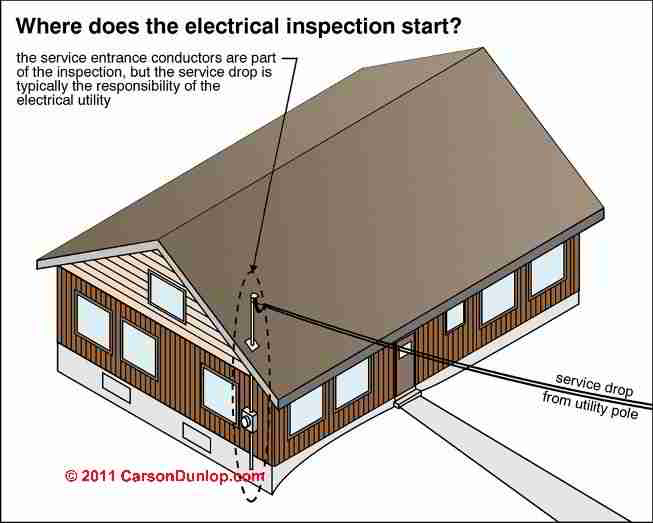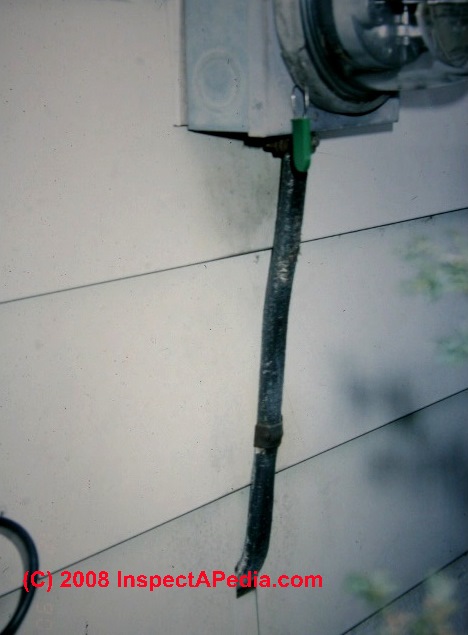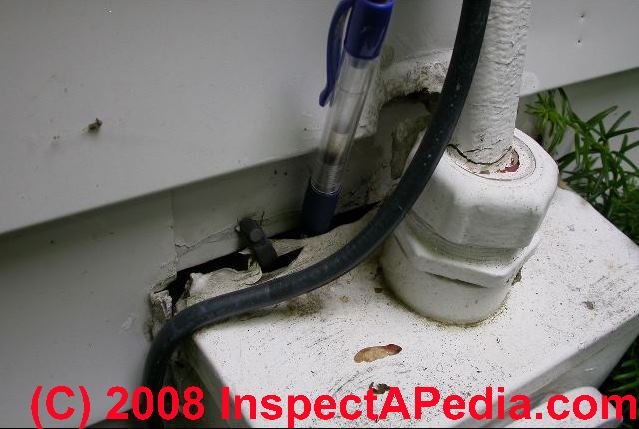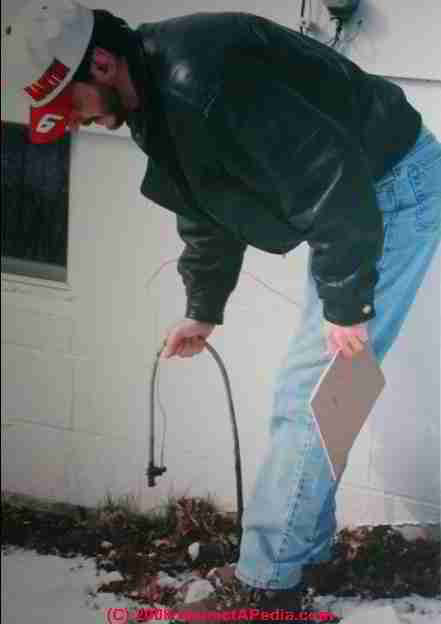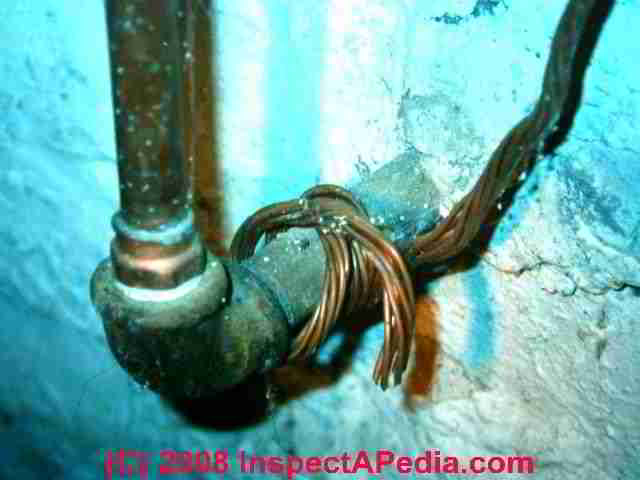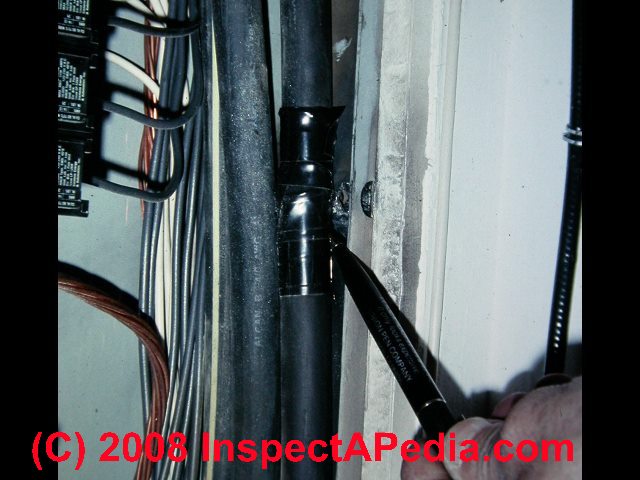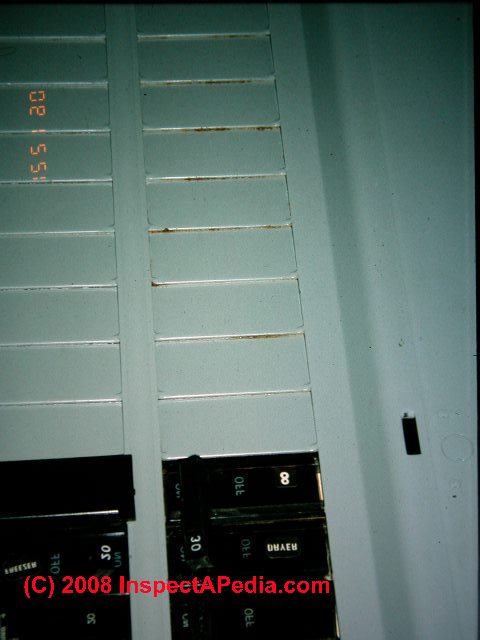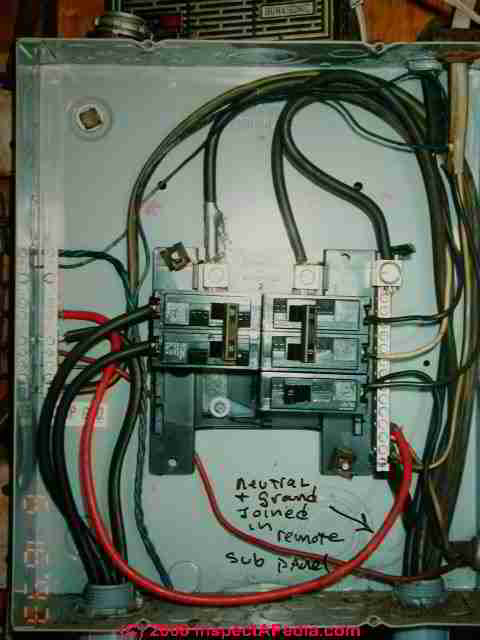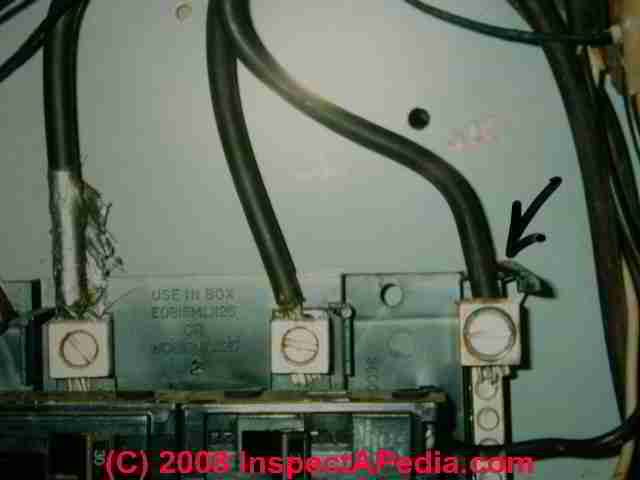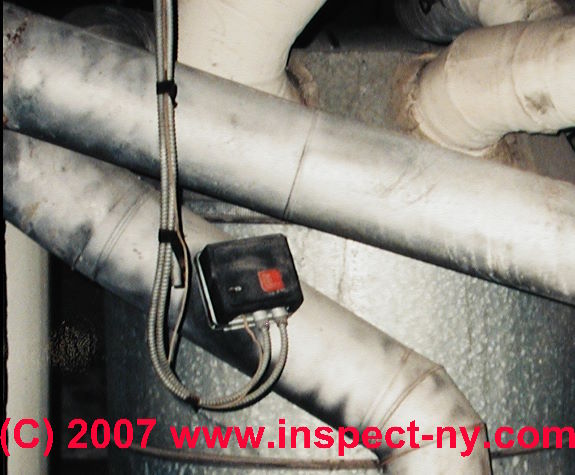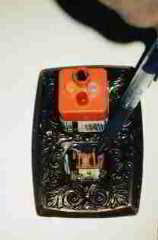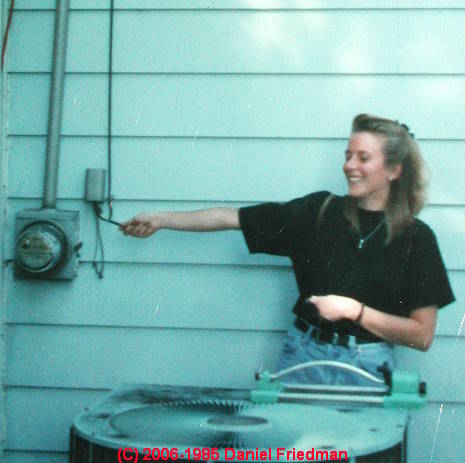 Electrical Safety Hazards & Safe Electrical Inspection Procedures
Electrical Safety Hazards & Safe Electrical Inspection Procedures
for Electrical Inspectors & Home Inspectors: free online class
- POST a QUESTION or COMMENT about safety procedures when inspecting electrical panels
Safety procedures for electrical inspectors & home inspectors:
This electrical safety procedures article discusses safety hazards at residential electrical systems both outside and indoors, and suggests safety procedures for the electrical inspector, home inspector, or other professionals who examine residential electrical systems.
Safe electrical inspection procedures and safe use of volt meters, DMMs, multimeters, and similar electrical test equipment is discussed at the end of the article.
Page top photo: an ASHI staff member pointing to an obsolete electrical meter during an field class conducted for ASHI staff by the author.
InspectAPedia tolerates no conflicts of interest. We have no relationship with advertisers, products, or services discussed at this website.
- Daniel Friedman, Publisher/Editor/Author - See WHO ARE WE?
Safety Suggestions for Electrical Inspectors:
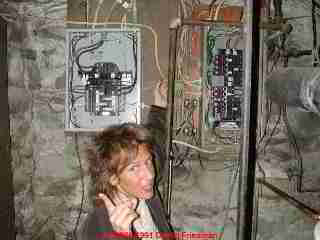 Electrical System Inspection Safety Procedures, Observations, Reports: free online class
Electrical System Inspection Safety Procedures, Observations, Reports: free online class
ASHI Home Inspector Educational Seminar Proceedings: ASHI-NE Chapter Annual conference
September 22-23, 2008, Randolph, MA. -- Daniel Friedman.
Original text - Daniel Friedman, as ASHI Technical Journal Staff, January 1992, updates February 2006, September 2008, June 2015, August 2015, May 2023.
These electrical inspection suggestions are not a complete inventory of all electrical safety procedures nor of all electrical components that should be inspected; these notes focus on identification of conditions that may present special electrical hazards for the electrical inspector.
Article Contents
- SAFETY for ELECTRICAL INSPECTORS
- ELECTRICAL HAZARDS WARNING
- FATAL ELECTRICAL SHOCK CURRENT
- ELECTRICAL HAZARDS OUTSIDE
- ELECTRIC METER & SEC HAZARDS
- ELECTRICAL GROUNDING HAZARDS
- ELECTRICAL PANEL INSPECT BEFORE TOUCHING
- ELECTRICAL PANEL COVER HAZARDS
- ELECTRICAL PANEL COVER SCREW SHORTS
- ELECTRICAL PANEL INTERIOR HAZARDS
- MAIN BREAKER INSPECTION & TEST
- ELECTRICAL CIRCUIT BREAKER TEST
- ELECTRICAL WIRING INSPECTION
- ELECTRICAL DEVICE INSPECTION & TEST
- ELECTRICAL POWER SHUT DOWN: WHEN-TO
- ELECTRICAL TEST EQUIPMENT, BASIC
- HOW TO TURN OFF ELECTRICITY in a WET or FLOODED BUILDING
- SAFETY PROCEDURE SUGGESTIONS
- SAFETY WARNINGS to OWNERS / OCCUPANTS
- ELECTRICAL SAFETY COURSES
Page provides is the full text version as web pages.
A powerpoint presentation version of this original class is also available as a free download [ELECTRICAL SAFETY POWER POINT SLIDES - 13MB PPT file.]
Warnings about Death from Electrical Hazards
Electric shocks are responsible for about 1,000 deaths in the United States each year, or about 1% of all accidental deaths.- Refs.
Fatal Shock Hazard Warning: Inspecting electrical components and systems risks death by electrocution as well as serious burns or other injuries to the inspector or to others. Do not attempt these tasks unless you are properly trained and equipped.
Homeowner advice for electrical panel safety:
These safety suggestions are for professional inspectors and are not a guide for homeowners.
Homeowners should not remove the cover from an electrical panel
- it is unsafe to do so. Homeowners should look at their electrical equipment for signs of trouble and should contact a licensed electrician to address any concerns that arise.
Without removing the electrical panel cover, but by opening the hinged electrical panel access door, homeowners can access the main circuit breaker or fuse, as well as individual circuit breakers and fuses. These devices may be turned on or off by the homeowner as safety or other needs require.
Reports of deaths during home inspections:
ASHI, the American Society of Home Inspectors, has reported (to DF) a single death of an inspector while at work. A Canadian home inspector fell from an improperly installed steel ladder "affixed"
to a multi-story building. That tragic death which was reported (by NY Metro ASHI News) in 1990.
Inspectors climbing in, on, around buildings should guard against becoming complacent, overconfident, or careless. ASHI Standards of Practice provide that an inspector may refuse to enter, inspect, access any component based on concern for safety. In our photo the inspector is pointing out how easily an inspector might touch live electrical components while also becoming grounded by a gas pipe.
Reports of injuries during home inspections:
There have been reports of falls and fall-related injuries, reports of electric shock, reports of threats of violence, and one report of an attempted murder of a home inspector by a real estate agent. [SV to DF, New Paltz NY, re D.B. realtor, ca 1992].
As of September 2008, we have not heard reports of serious injuries to home inspectors or their clients during the inspection of electrical components. Electrical shocks, injuries, and fires certainly occur in residential as well as commercial environments.
How much electrical energy would it take to kill a home inspector?
Wet skin (standing in water, sweaty) has a resistance of about 1000 ohms. (Dry skin will have a higher resistance, and of course an inspector wearing protective gear such as rubber gloves, rubber-soled shoes, standing on an insulated mat, will have still higher electrical resistance, and safety.)
At this skin resistance, a current of only 0.1 to 0.3 amps at 100 Volts is sufficient to cause potentially fatal ventricular fibrillation. -- Wikipedia September 2008.
Home Inspection Standards Require Dangerous Activities:
 Since the Standards of Practice for home inspectors (such as those published by ASHI, NAHI, CREIA, and CAHI) require home inspectors to
open electric panels, a task not performed in many states during some other types of inspections, we and our clients face additional risks.
Since the Standards of Practice for home inspectors (such as those published by ASHI, NAHI, CREIA, and CAHI) require home inspectors to
open electric panels, a task not performed in many states during some other types of inspections, we and our clients face additional risks.
The gruesome death by electrocution shown in the photograph occurred when the man shown tried to steal electrical power from a high voltage cable. - Jim Simmons To respect Google's insistence that the material was too painful to show publicly we've overlaid the small photo above with a warning. Click the image to see the actual fatality image.
In a much less serious incident, the author had the personal experience of having a client ask "What's that?" as he reached over our shoulder to stick his finger right into an open fuse socket.
Among many reports of fires and accidents whose origin was suspected to be electrical, are reported deaths of a number of electricians and electrical workers - people working in some of the same high-risk areas examined by inspectors.
Portions of the ASHI Standards of Practice for home inspectors is commented upon below.
ASHI Standards and other building inspection standards are revised from time to time, and the version of Standards discussed here may be obsolete. However the principles discussed and cautions advised will apply to newer versions of building inspection standards as well.
ASHI is the American Society of Home Inspectors - see www.ashi.com. Other home inspection professional associations such as CREIA, NAHI, FABI, TAREI, CAHI, NACHI, and the various U.S. states who license home inspectors have published their own versions of these standards. Home inspection standards are a definition of the scope of practice - what the inspector is obligated to do or not do.
ELECTRICAL INSPECTOR SAFETY PROCEDURES describes important basic safety procedures, clothing, and equipment for home inspectors and electrical inspectors.
At ELECTRICAL SAFETY ARTICLES we provider a list of just that: safety procedures for building inspectors, electricians, owners, clients, contractors.
The Electrical Panel Inspection for Water & Rust Begins Outside
8. System: Electrical Inspection Standards for Home Inspectors (ASHI and other Associations & State Regulations)
8.1.C. [The inspector shall observe] amperage and voltage ratings of the service
Keep in mind that this determination is required by ASHI Standards and is to be derived based on visual inspection of the wiring and equipment. It is not required to use test equipment for this purpose.
Sketch courtesy of Carson Dunlop Associates, a Toronto home inspection, education & report writing tool company [ carsondunlop.com ].
see OUTDOOR ELECTRICAL INSPECTION SAFETY for details of outside electrical inspection safety procedures.
See ELECTRIC METERS & METER BASES for a discussion of examining the electric meter and meter base portion of the service entry.
See AMPS& VOLTS DETERMINATION for determining the ampacity of an electrical service: How to determine the electrical Ampacity and Voltage provided to a building discusses in detail how to determine the service amps and voltage by visual inspection.
Also see AMPACITY - the LIMITING FACTOR.
Inspection of the Electric Meter and Service Entry Cable
Pay special attention to water entry at the service entry cable, at the top of the electric meter enclosure, and at the wall penetration where the SEC enters the building as these conditions can send water into the electrical panel where corrosion creates unreliable equipment and water is a hazard.
- The frayed service entry cable (photo above) and lost wire-clamping seal around the service entry cable at the top of the electrical meter box (left) send wind-blown rain into the enclosure.
- The bottom of the electrical meter enclosure acts as a funnel
to collect and send rainwater into the interior of the service entry cable where it is conducted as if in a plastic pipe, right into the top of the electrical panel located below this point inside the home.
A photo later in this article shows the water entry tracking stains at the SEC in the main panel. - Capillary action sends rainwater following the outside of a service entry cable right into the building if the cable is not sealed at the wall penetration (photo below).
See ELECTRIC PANEL RUST for a study of water entry, rust, and corrosion in electrical panels presented at the 1992 IEEE Holm Conference.
Dropped sheet metal screws & loose electric meter boxes:
be careful about dropping a metal screw into or onto live electrical parts.
If you see that the electrical meter box is loose on the building wall, do not touch it.
A loose mounting screw can fall into the meter box, shorting electrical components there and leading to a house fire. -- Arnold Road Poughkeepsie NY house fire - J. Aronstein & D. Friedman.
See ELECTRIC METERS & METER BASES for procedures used for inspecting these outdoor components.
Inspect the Local Electrical Grounding Electrode or Grounding Connections
- Do not assume that the grounding electrode is a real one. Kick it. We find short scraps driven into the ground that can sometimes just be pushed over or pulled out, as our client is demonstrating.
Often ground connections have come loose, were never connected, or have corroded away. The ground connection shown here is not reliable. The inspector has easily lifted the short ground rod out of the ground. (Photo above)
- Do not assume that the utility company's ground
(back at the pole) is connected and working. Sometimes that ground has been lost and only the local ground is present - a very dangerous condition.
See DOUBLE FAULT, LOSS OF ELECTRICITY for an account of loss of both local ground and utility company ground at a property.
- Do not assume that water pipes form a good ground - original metal pipes extending into the soil may have been replaced with plastic. (Photo above)
- Do not assume that grounding connections you see are actually secure and making good electrical contact.
Details about inspecting electrical grounding and definitions are
at ELECTRICAL GROUND SYSTEM INSPECTION.
Safety Procedures for Removing Electric Panel Covers: for Electrical Inspectors & Home Inspectors
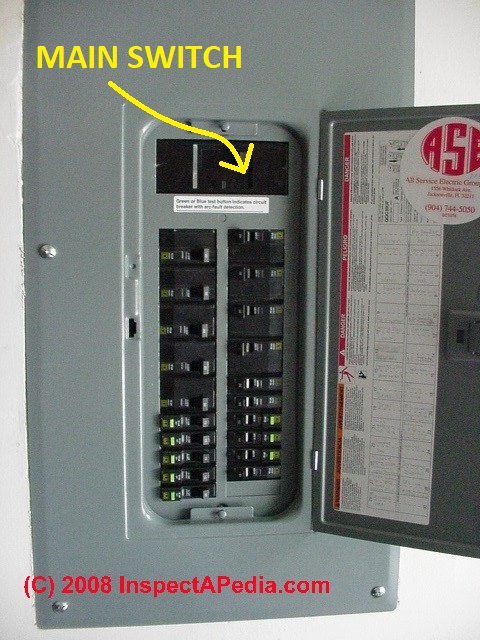 ASHI Standards 8.1.B [The inspector shall observe] service equipment, grounding equipment, main overcurrent device, main and distribution panels.
ASHI Standards 8.1.B [The inspector shall observe] service equipment, grounding equipment, main overcurrent device, main and distribution panels.
Details about this topic are in this separate article:
ELECTRICAL PANEL COVER REMOVAL
- Keep a Safe Distance:
Warn clients to remain at a safe distance away from both the electrical panel (or other electrical components) and from anyone touching them such as an inspector or an electrician performing work on the system. - Assistance? No thanks:
Do not permit your client to assist you in removing or installing the panel cover. Only one person should be touching electrical components at any time.The author asks clients to stand a little back while removing the cover, which makes it easier to remain in a blocking position (below).
We might inform the client that opening the panel is a dangerous step, and that if sparks fly the client should not touch the inspector - though other parties present at the inspection might want to kick the inspector or take similar measures if necessary.
- Block the client:
Stand so as to block your client from touching the panel or its components. - No Touching:
Watch out: do not touch the electrical panel cover before checking for visually-detectable unsafe conditions such as
Standing on wet floor
- No safe clearance distances
to access the panel while maintaining an escape route to move out of a discovered unsafe condition, especially lack of clearance disdtance to metal or grounded objects
- Loose electrical panel cover or faceplate
that may mean breakers or fuses are loose and may fall out
- Spring-loaded electrical panel faceplate
(like the one in our photo above) that may be holding circuit breakers in place: removing the cover may lead to a dangerous, even fatal electrical arc explosion
- Signs of arcing or shock hazards
such as arc burn marks at cover screws or the use of pointed sheet metal screws to secure the cover or faceplate of the panel (SMS screw heads replacing original screws)
- Signs of rust, corrosion
that may make the breakers unsafe
Watch out: Do not permit your client to touch electrical equipment.
- Grounding:
Check visually (and electrically if needed) for presence of system grounding before touching electrical components.
Details about inspecting electrical grounding and definitions are
at ELECTRICAL GROUND SYSTEM INSPECTION.
And don't count on the safety of the "backup ground" back at the utility company's service lines and poles: that ground may have been interrupted too.
See DOUBLE FAULT, LOSS OF ELECTRICITY for an account of loss of both local ground and utility company ground at a property.
At an inspection in a damp dark crowded basement the author was standing blocking the very curious and active participatory client from the open electrical panel after the cover had been removed.
The client reached over the author's shoulder.
The client asked, "What's this?" as he stuck his finger straight into an open fuse socket while his arm contacted the inspector's shoulder, assuring that they both would get an electrical shock.
Electrical Panel Cover Fastener Screws & Electrical Meter Box Mounting Screw Hazards
- Look first:
Look carefully for evidence of burning, arcing, or other damage before touching or moving components. Eg.: sharp sheet metal screws in panel covers may short hot wires.
- Unsafe Electrical Panel Screws:
the electrical panel cover screws have been replaced with sharp pointed sheet metal screws - details are
at ELECTRICAL PANEL COVER SCREWS - Electrical Panel Access, Rats & Other Distractions:
(distractions from being careful) there are rats at your feet, or there is a rats nest of wires or other obstruction to safe cover removal - watch what you say.
At an inspection the author had encouraged a nervous buyer to accompany him into an ugly dark muddy basement to inspect the mechanical systems.
The client, a woman not properly dressed for an inspection, wore high heels and a tight skirt.
She was wobbling in the dirt floor in a dark crowded corner of the basement, terrified and already shaking in the dim light. The author, encountering a maze of wires in the way of the electrical panel, forgot to edit his thoughts, and muttered aloud: "geez what a rats nest."
The client screamed "RATS!!!" and ran terrified from the basement, falling towards the dark stairs.
- Distractions during an electrical inspection are themselves dangerous. A NE ASHI inspector reported that
As I just touched an electrical panel cover screw with my Milwaukee screwdriver I saw a tremendous flash of light - as bright as the sun.
I was certain I was dead. As moments passed I realized I was still standing there, alive. Am I alive? I asked myself. I learned that from behind me and my client, the real estate agent had chosen that moment to take a flash photograph of the proceedings. - to DF Randolph MA 09/2008
This distraction is more risky than it may appear. A sudden flash, a sudden shout or movement, could cause an inspector to lurch, touching an electrically live and dangerous component. It is important for the inspector to learn and practice calm, steady movements and to resist distractions.
How to Look for Unsafe Panel Cover Screws & for Evidence of Burning and Arcing When Approaching the Electrical Panel
- Look at the electrical panel before touching
the electrical panel cover; is there evidence of a problem such as - Arcing, Overheating or Burnups:
you see evidence of electrical failures such as burned or overheated components. In the photo at left the ground wires are clearly overheated - something is wrong. In this case a homeowner was badly shocked when he touched his metal workbench.
See LOST NEUTRAL SHOCKS HOMEOWNER for details.
The pair of photos shown earlier and just below show electrical arc flashover soot (above), and at right, the repair - tape (below) on the electrical wire, but the wire is still too close to the screw mounting hole for the panel cover.
- Look for improper and unsafe electrical cover screws,
sharp pointed sheet metal screws, and look for electrical cables that pass too close to the screw openings in the electrical panel.
 Sharp sheet metal screws:
Sharp sheet metal screws:
If you find that a sharp-tipped sheet metal screw has been used (usually to replace a lost original fastener) you should
be alert for pierced, damaged, short-circuited wires in the panel - both during removal and during panel cover replacement.
We will not reinstall a sharp-pointed screw in a panel cover if wires are crowded close to the screw opening.
Having seen more than one shorted and burned panel from precisely this cause, we warn clients about this unsafe detail. It is trivial to correct.
It's an easy fix: use a blunt tipped screw, or file off the sharp point of the SMS.
Before re-installing the cover of the electrical panel, check to assure that no electrical wires have moved close to the panel cover screw mounting holes where they might be pierced or damaged.
Now that we have removed the cover and carefully set the cover and screws aside (don't lose the screws),
Details about unsafe electrical panel cover screws are in this separate article: ELECTRICAL PANEL COVER SCREWS
Safety Suggestions for Inspecting the Electrical Panel Interior
Watch out: before touching or trying to open the electrical panel cover be sure you have reviewed
8.3.C. [The inspector is NOT required to] dismantle any electrical device or control other than to remove the covers of the main and auxiliary distribution panels.
Details of this topic are in a separate article:
ELECTRICAL PANEL INTERIOR HAZARDS
How might the astute inspector spot trouble in an electrical panel cover before opening it?
At least one death, that of an electrician, has been reported to have occurred during the removal of a panel cover
Atlanta GA, a licensed electrician was opening the panel for inspection.] Apparently there was an incipient problem with the spring-loaded bus-bar assembly. When the cover was removed the bus assembly moved, an arc caused an electrical explosion, killing the inspector. -- J. Aronstein to D. Friedman, personal communication, 12/1991.
The following photos and text provide examples of external evidence that may let the inspector avoid trouble or a nasty surprise when inspecting electrical equipment.
Before touching the electrical panel the inspector should look for these conditions:
- Escape path:
make sure that you know where you will turn and/or step back to retreat from the equipment if you discover a sudden and dangerous surprise (sparks, rats, bees, etc). - Wet floors or other wet conditions:
- Do not touch electrical equipment if you are standing on a wet surface.
- Notice the cold water pipe condensation dripping onto and into the electrical panel in the left hand photo below
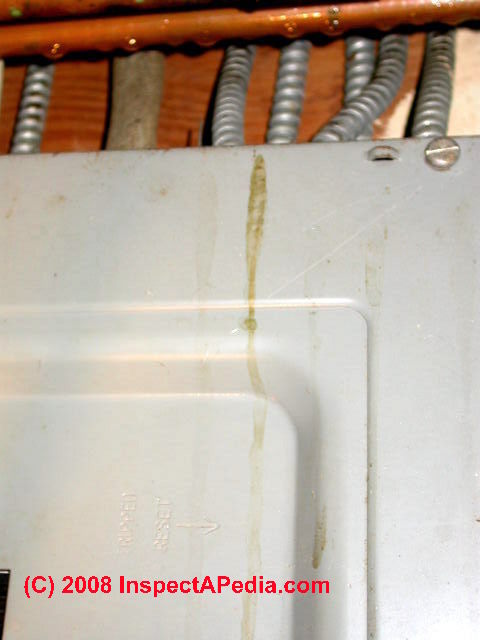
This photo shows a common way that water may enter an electrical panel as well as drip on its exterior.
A cold water pipe produces condensation which drips on the panel top. This pipe is too close and is in a poor location over this electrical service box.
Is there:
- Wet electrical equipment:
the electrical panel cover is wet - Electrical Panel Rust:
the electrical panel cover is rusty
The pair of photographs above and below show two clear warnings that water has been entering an electrical panel - watch out for rust, and for circuit breakers that may not trip in response to an overcurrent, due to internal corrosion.
This defect is not one for which a home inspector (nor most electricians) can reliably test in a home, but the warning remains appropriate. Replace such breakers, and if the electrical panel is badly corroded the entire panel needs replacement.
See RUST in ELECTRICAL PANELS for a detailed account of the sources of water and rust in electrical panels and the frequency of observation of rust and water damage in that equipment.
What to Look for Inside the Electrical Panel as Immediate Safety Concerns to the Inspector
Above: water entering this electrical panel through the SEC left white tracks down the black electrical wire insulation.
- Evidence of water entry inside the electrical panel
(photo above means that circuit breakers may be corroded and won't trip, connections may be unreliable, neutral or ground connections may be lost, and touching the equipment could be dangerous. - Evidence of overheating, melting, burnups inside the electrical panel (photo below) - this was the ground that overheated when there was no neutral connection in the sub panel and neutral and ground buses were improperly bonded.

- Evidence of missing bonding or improper bonding
(such as ground to neutral in a sub panel) may combine with evidence of overheating (photo above left) to indicate improper wiring, damaged equipment, and unsafe conditions.
The loss of net ural in a garage sub panel (the steel screw bound in the aluminum neutral lug in photo at below right) combined with improper bonding (ground to neutral - red wire in photo at below left) and other conditions to shock an owner when he touched his metal workbench.
See CASE HISTORY: Loss of Neutral SHOCKS HOMEOWNER or details of this case.
and
- Evidence of burned or overheated wires
or damaged circuit breakers,
aluminum wiring,
faulty equipment,
mis-wiring,
linking errors,
bus and bonding defects,
and many other defects form part of the electrical panel inspection and are described outside of this safety procedures article -
see ELECTRIC PANEL INSPECTION
Testing Main Circuit Breakers or Main Fuses in Electrical Panels
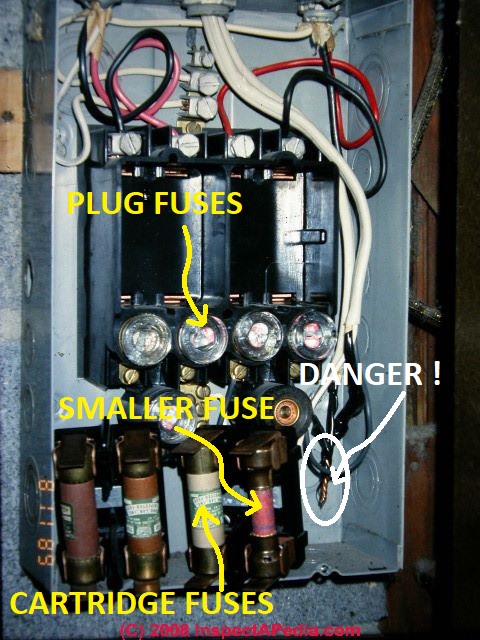 8.3.B. [The inspector is NOT required to] test or operate any overcurrent device except Ground Fault Circuit Interrupters
8.3.B. [The inspector is NOT required to] test or operate any overcurrent device except Ground Fault Circuit Interrupters
I continued to put my arm behind my back and close the breaker with my left hand with my head turned to the left.
BAM, a light as bright as the sun and an explosion. This knocked us down and blinded us.
We were rushed to the hospital. I spent the night in the ER with an ICU nurse and was off of work for 3 weeks and have had to have a stronger prescription. These FPE panels are all over the building
Pulling fuse blocks:
At one inspection the author pulled the main fuse block in a 60-Amp
panel, only to have the pullout block disintegrate in his hand.
The failure left one fuse in place and one half out of the panel.
"What
did you just do to the panel?"
asked the client (from a safe distance).
"I destroyed it." was the answer.
With permission of the owner, and following accepted home inspection practice of exercising normal user controls intended for use by the homeowner, the home inspector was performing a normal, if uncommon operation which a homeowner would be expected to do, for example, during an emergency or other need to shut off electrical power to the building.
At a minimum one would have had to perform this operation during an emergency or if the panel were to be worked on.
The client wanted to know if the fuse pullout disintegration was normal. [No.]
The inspector wanted to know if he was going to pay for a new panel. [No.] [A new panel was needed as the service and equipment were obsolete, not because the fuse pullout needed replacement.]
If you had not pulled the fuse shown at lower right in this photo, something interesting would have been missed.
Is that smaller fuse unsafe? What about the other wiring in the panel? Are some of the edison-base fuses oversized?
Safety Procedures When Inspecting Branch Circuit Conductors, Breakers,Fuses, &c.
8.1.D. [The inspector shall observe] branch circuit conductors, their overcurrent devices, and the compatibility of their ampacities and voltages
In addition to examining the electrical panel before touching it, looking for dangerous conditions like water, rust, sheet metal screws, rats, and blocking client access, the inspector should also recognize that certain brands or models of electrical equipment are known to be unsafe and may be dangerous to inspect or operate.
Federal Pacific Electric Stab-Lok equipment includes breakers which remain internally "on" when switched "off", as well as too often failing to trip off in response to an overcurrent, and which have been reported to result in electrical arc explosions when manually or otherwise exercised.
Zinsco: Similar bus burnups and electrical arc explosions have been reported regarding Sylvania/Zinsco electrical panels.
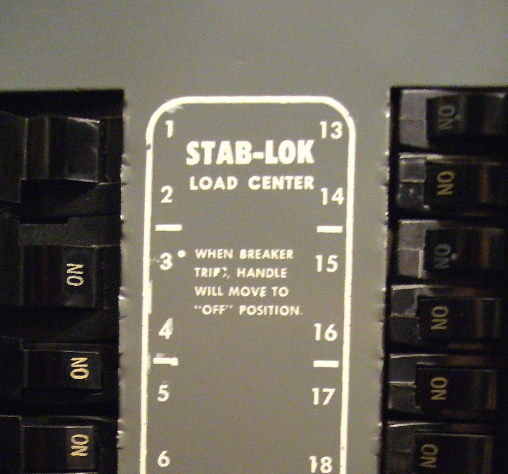 Opening the electrical panel to examine overcurrent devices - fuses or circuit breakers, is discussed at ELEC PANEL & GROUND
Opening the electrical panel to examine overcurrent devices - fuses or circuit breakers, is discussed at ELEC PANEL & GROUND
Inspecting overcurrent devices - visual:
and ELECTRIC PANEL INSPECTION for detailed procedures. There is a huge amount of information about the electrical system inside of the electrical panels.
Reporting unsafe electrical panels: see FEDERAL PACIFIC FPE HAZARDS
and see ZINSCO SYLVANIA ELECTRICAL PANELS
The inspector is not required to insert anything, finger, screwdriver, probe, into the electrical panel.
The required inspection is visual. Observe. However an inspector is of course permitted to perform other tests or services which s/he chooses to provide (presuming s/he is qualified, trained, and that three are no conflicts of interest).
Inspecting Electrical Branch Circuit Wiring
Inspecting wiring - visual: gain, a visual inspection of the wire size compared with breaker ratings is what is meant by this section. If you need them, plastic, non-conductive wire gauges are available. Do not use metal wire gauges in or around electrical equipment.
Reporting aluminum wire:
see ALUMINUM WIRING HAZARDS & REPAIRS
Reporting knob and tube wiring:
Safety Procedures When Inspecting Electrical Outlets, Switches, Lights
 8.1.E. [The inspector shall observe] the operation of a representative number of installed lighting fixtures, switches, and receptacles located inside the house, garage, and on its exterior walls
8.1.E. [The inspector shall observe] the operation of a representative number of installed lighting fixtures, switches, and receptacles located inside the house, garage, and on its exterior walls
Before operating a switch or device perform a visual inspection for damage, looseness, burning or arcing, or heat.
Devices missing cover plates are unsafe and risk both shock and fire.
Metal cover plates also add shock risks.
Watch out: about turning on switches found off in the service panel.
A circuit found in the off position may be that way due to an unsafe condition or a repair in progress. Leave it off and document the finding.
The property owner should be consulted for permission before turning on any electrical device which has been found shut down.
The light shown in our photo is a fire hazard and needs to be moved or replaced with an enclosed florescent fixture.
Also be careful about turning off switches found on. You may damage a computer data base, turn off a heart-lung machine, reset an alarm system, or turn off a marginal switch for the heat that leaves the property with no heat in freezing weather. Be safe and avoid disputes.
An example of accidentally switching off circuits in a building occurs often during removal of an awkward electrical panel cover - it's easy to accidentally push one or more circuit breakers into their off position during cover removal or replacement.
Inspecting and Testing Electrical Receptacles or "outlets" and GFCI-Protected Receptacles

8.1.F. [The inspector shall observe] the polarity and grounding of all receptacles within six feet of interior plumbing fixtures, and all receptacles in the garage or carport, and on the exterior of inspected structures
Testing is commonly performed using one of a variety of electrical testers.
First perform the visual inspection for overheating, looseness, arcing as noted above for switches. If a device is quite loose we do not test further but report it as a required repair. [See "Electrical Receptacles" in this issue.]
8.1.G. [The inspector shall observe] the operation of Ground Fault Circuit Interrupters.
While manual operation of these devices using their internal test button is possible, experience and information about the construction and operation of these devices and the circuits which they serve suggest that testing using GFI-test equipment adds additional information and will find defects not disclosed by manual operation. See "GFCI's" in the original issue of the ASHI Technical Journal.
AFCIs: The requirement to inspect and test AFCIs is already in some regulations for home inspectors.
It seems likely that remaining home inspection associations and state or provincial inspection standards-writers will soon update their electrical inspection standards section to address the new requirement for AFCI's.
See AFCIs ARC FAULT CIRCUIT INTERRUPTERS for details of the electrical code changes regarding the requirement for arc fault interrupters in homes.
AFCIs can be properly tested only by using the test button on the device itself. External tool tests are incomplete and therefore unreliable.
When to Shut Down Unsafe Electrical Equipment
Some inspectors, with adequate training, exceed the requirements of the standards and will actually shut down extremely dangerous equipment themselves.
Watch out: Even the simple task of pulling the cover on a marginal bimetallic stack relay switch on an oil-fired heater can result in failure or inadvertent shutdown of the equipment.
Stack relays have a stepping lever which is reset by the service person if the switch, often fragile on old systems, is disturbed.
Be warned that whether you touch a building component or not there are grave responsibilities.
Touching a building component: if you precipitate a catastrophe, will of course be viewed as a mistake.
Watch out: Not touching a building component: Failing to act effectively to protect occupants of a building you inspect will, of course, also be viewed as a mistake. If you failed to inspect, detect, report a hazard in a building you may bear liability if later an event occurs.
Disclaimers: A simple disclaimer "not inspected" is in adequate. An adequate disclaimer that meets ASHI standards makes sure that the client understands the significance of an observation [or of steps to omit making an observation].
The last man in rule: Trade and professional education classes concerning mechanical systems, which can involve life-safety concerns, commonly teach the "last man in" rule. Home inspectors know this problem as well.
The last "expert" to set foot on the property is vulnerable to blame for any ensuing failures, even if s/he acted entirely correctly and even if s/he never touched the component later in question.
During an electrical inspection, it's your judgment call. Document your judgment
In the final analysis then, the precise safety steps to be taken are up to the judgment of the inspector at the scene. The inspector should also document his or her action. Failing to do anything and failing to even serve notice may be viewed as very dangerous and seriously irresponsible.
With proper training, knowledge, and procedures, electrical inspections can be done safely and accurately. Be careful.
Touching Electrical Equipment During an Inspection?
- Never touch metal plumbing or gas system pipes while you're working around electricity.
- Never touch electrical equipment while standing on a damp or wet surface. [Unless you are trained and are wearing appropriate protective gear.]
Shocked homeowner:
During an inspection an ASHI inspector warned the home owner that
there was a short in a florescent ceiling light fixture. T
he owner, a contractor who had done his own electrical work, irritated and incredulous at this supposed defect, licked his knuckles and bridged a small space between the light body and a nearby gas pipe. He's now a believer. [NOTE: DJF home inspection, Beacon, NY 1990]
Amazing Al Alk:
A very questionable procedure is suggested in The ASHI Training
Manual [NOTE: "Electrical Systems," ASHI Training Manual,
chapter by Alfred L. Alk, p. 18. ASHI 1987] indicating that the
inspector can "test" to see if a panel is dangerously "live"
(has an internal short) by tapping the box with the knuckles of his/her
right hand to check for current, then laying the right palm on the
box to feel for heat before beginning to remove the cover.
Watch out: DO NOT RELY ON THESE UNSAFE METHODS suggested by Mr. Alk.
From a safety view, this is a bad idea. Never rely on physical touch to judge electrical safety of a component.
Details about the hazards of touching electrical equipment and alternative advice for determining whether or not equipment is safe to inspect are provided at Touching Electrical Equipment.
Also see Guide to Electrical Test Equipment
as well as ELECTRICAL INSPECTOR SAFETY PROCEDURES for electrical inspectors.
Guide to Using Electrical System Test Equipment to Check System Safety
First use your head:
Stop, look, listen before touching. More on "just looking" is provided when we discuss opening the electrical panel. Do not rely on touch to determine if electrical equipment is safe. Details about the hazards of touching electrical equipment and alternative advice for determining whether or not equipment is safe to inspect are provided
at TOUCHING ELECTRICAL EQUIPMENT
Using a Tic Tracer to Test for Presence of Voltage
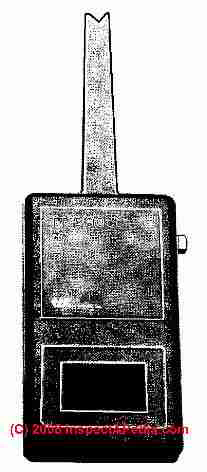
This is a superb safety tool for testing for the presence of live 120VAC or 240VAC because you do not actually need to touch the tool to anything - just hold the tool near a source of electrical power and the electrical field produced will cause the tool to generate its tone.
Faster "ticking" indicates higher voltage; slow ticking can indicate a wire connected to a live circuit even if the wire is not presently conducting current.
With practice the inspector can guess the voltage level from the tone quality.
We use this tool to check light sockets for power when there is no bulb or the bulb is dark.
We also use this tool to look for lost or hidden wiring in walls and ceilings.
Its sensitivity falls off with the square of the distance from the source of electrical power.
Weird and interesting behavior of the TIF Tic Tracer: Some ASHI NE chapter inspectors pointed out that this device can be "fooled" into thinking that a wire scrap is "live" or that even a pipe is electrically "live" when it is not.
If a live electrical wire passes close enough to another metal device such as a pipe, electrical conduit, or armored cable, the metal device, conduit, or cable may pick up the electrical field generated by the "live wire" and appear "live" itself when it is not.
(This is a "safe" error in that it errs in the direction of warning that something is live when it is not.)
This tool will also respond to momentary static electricity. In winter, simply rubbing its tip quickly across a wall can produce a momentary sound response. (Which can be fun in certain circumstances.)
The Tic Tracer™ is discussed further at TOUCHING EQUIPMENT.
Inspectors who object to the "false positive" possibility make use of a light-pen or similar tool which performs similar functions with less sensitivity to false positives.
Using a Neon Tester
A simple neon tester is perhaps the simplest, most versatile tool for checking for the presence or absence of voltage.
Just touch one leg of the tester to the surface to be checked (a wire terminal or an electrical panel enclosure).
Touch the second leg of the neon tester to a sure-ground such as a water pipe that you see continues into soil.
If voltage is present within the range of sensitivity of the neon tester's bulb, the bulb will light.
We discuss neon testers for voltage at Electrical Tools Every Homeowner Should Have
Using an Electrical Receptacle Tester
Receptacle testers are used by most home inspectors to check for proper wiring at electrical receptacles as well as to check the function of GFCI's.
For testing AFCI's the only reliable test currently available is the device's own test button.
We provide details about using receptacle testers
Neither of these neat little electrical test tools can be relied on to report low levels of current leakage.
At an investigation of a garage roof that shocked a crew of builders during reconstruction after a lightning strike, we measured voltage varying between about 38 volts AC and 68 volts AC between some framing components and the earth. We could not detect these conditions with a neon tester. A VOM or DMM was needed.
Using a DMM or VOM to Check for Current
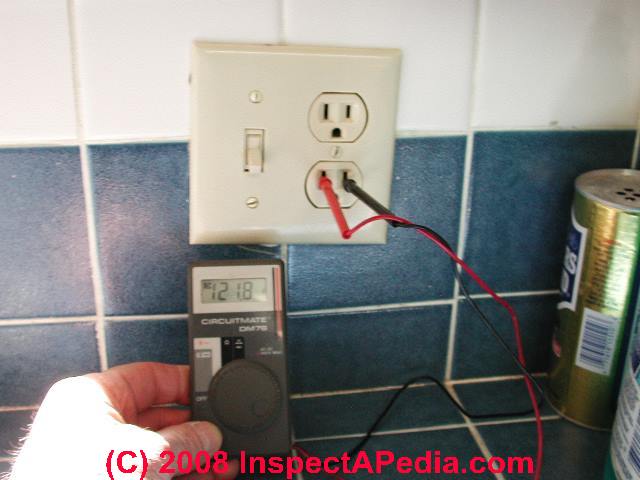
A simple volt ohm meter volt-ohmeter (VOM) such as the TriplettTM 310 or our little mini digital multimeter (DMM) shown at left can be used to test for unexpected and unsafe voltage at a component.
- Set the VOM in the highest AC-voltage range.
- One probe is used to contact the surface of the electric panel (or any component to be examined)
- The other probe is touched to a reliable ground source, or in the example shown, to the neutral side of the circuit.
NOTE: Once having tested at the highest voltage range, greater accuracy may be obtained by choosing more sensitive ranges which permit readings to be taken in the upper portion of the scale.
Disconnect the test probes (or shut off the voltage source) before changing the voltage range setting on the VOM.
Details on safe use of DMM's and VOMs are
at DMMs VOMs SAFE USE OF.
For example, if the meter indicates more than 1or 2 volts between a service panel cover and ground, there's a safety problem. Most low-cost analog-type meters such as the one described provide additional ranges used to read lower voltages with more sensitivity.
Some VOM models provide alligator clips for the ends of the test probes. These clips permit measuring high voltage without handling the probes. Always shut off the power before connecting the alligator clips.
Safe Use of Electrical Test Equipment: DMMs & VOMs
8.3 During an electrical system inspection the inspector is NOT required to
8.3.A. insert any tool, probe, or testing device inside the panels
How to Test digital volt meter DMM or Volt Ohm Meter VOM meter condition

In some circumstances ASHI inspectors may elect to make
current and voltage measurements. For inspectors who elect to use
these tools, make sure that the tools themselves do not become a source
of damage, or injury.
Use only DMM's (digital multi meters) or VOMs (volt-ohm meters, the analog predecessors to DMMs) designed for high energy measurements.
Details about safe use of VOMs and DMMs are provided
at DMMs VOMs SAFE USE OF.
These electrical inspection suggestions are not a complete inventory of all electrical components that should be inspected; these notes focus on identification of conditions that may present special electrical hazards for the electrical inspector.
Contact Us by email to suggest changes, corrections, and additions to this material.
General Safety Suggestions for Electrical Inspectors
Pay attention, look carefully, move slowly before opening or exploring electrical equipment. Learn to recognize indications of a problem, such as but not limited to the examples in this article.
Do not assume anything when performing dangerous tasks such as inspecting electrical equipment.
- Do not assume that electrical power is "off" without confirming that using proper test equipment and methods
- Do not assume that system grounding is complete and correct
- Do not assume that all circuit breakers and GFCI's and AFCI's will work
- Do not assume that bystanders or clients won't move suddenly into the path of danger, or push you into it.
Do not touch live wires or connections.
Watch your hands and other body parts. Handling live electrical wires without special training and equipment is highly questionable and often fatal.
December 12, 1988 - Madison, WI - Michael E. Hammes, 26, died in an apparent electrocution while working in Madison. Hammes had been hired by CUNA Mutual Insurance Society to change ballasts on fluorescent lights. Authorities said he was replacing a fixture in a fourth floor bathroom while standing on a stepladder when he slumped to the floor.
Hammes apparently was electrocuted when he touched live wire with one hand and a metal partition with his body or other hand, according to Dana County Coroner Ray Wosepka.
Hammes was a first-year electronics student. Wosepka said his investigation showed the light fixture had been properly wired. Hammes apparently replaced a ballast, a [transformer] that controls the electrical flow to the light bulbs, and was attaching the live wire when it electrocuted him, Wosepka said. -- Ibid.
If in your opinion unsafe conditions exist at a property
you are inspecting you should notify all parties concerned, including building occupants/management/owners, realtors involved, and other appropriate authorities.
December 18, 1988 - Smyrna, GA - A Smyrna family's troubles with a faulty circuit breaker in their mobile home ended in tragedy when a fire broke out and killed 18-year-old Jeffrey Scott Auton. Auton's family, experiencing problems with the main circuit breaker, went to a home products store to buy a new one for their trailer, said Fire Investigator David Herndon.
The store did not have a circuit breaker to fit the family's needs and a new one had to be ordered. .... Herndon said the fire was started when the circuit breaker shut down completely as three space heaters were running.
The family had
a history of problems with the breaker, particularly from a load put
on it by a large heating unit. Herndon stated that after the fire
there was not a trace left of the circuit breaker; it was completely
gone from
For example, what if the case above had happened the day after the property described had been examined by an ASHI inspector? Were there perhaps clues which telegraph a developing problem? What about anecdotal reports from the occupants of recurrent breaker tripping, visible signs of overheating in the panel, widespread and unusual use of electric heaters, or evidence of work in the panel by untrained people? These risks to occupants are also a hazard to the inspector on several bases.
Protect yourself and your client from injury using but not limited to the suggestions we provide here and just below.
Electrical Inspection Safety Suggestions from Rex Cauldwell, a Master Electrician
OPINION-RC: "As a master electrician, here is how I teach opening a service panel in my seminars: "The lucky 7""
- Eye protection:
Wear safety glasses--electrical panels have been know to explode upon opening. - Insulating gloves:
Wear rubber dishwashing gloves--panels have been known to become electrically hot as a screw falls when cover is removed. - Look before touching:
Don't approach the panel until you give an overall look of the surrounding area to see if anything looks wrong--such as water on the floor under the panel. - Avoid Shock Pathways:
Don't have any part of your body touching items adjacent to the panel. - Insulating floor pad:
On a concrete or dirt floor, lay down a thick rubber Welcome mat and stand on it as you open the panel (wear rubber-soled shoes). - Insulating tools:
Use insulated handle tools--I use a Milwaukee electric screwdriver. - Panel Door & Screws:
Once door is open (in a Federal Pacific panel (and some other models) beware of falling trim and breakers that pop out), set door aside and don't lose the screws
Further Safety Warning--DF:
these are helpful electrical safety suggestions from an experienced electrician. No list of suggestions is incomplete and these presume that they are being followed by an experienced, licensed electrician.
For example, there are almost certainly gloves and/or boots specifically recommended for this application; there are specific safety details to look at and for before touching an electrical panel, and procedures for using electrical test equipment to test or examine a suspect electrical panel.
Recommended books on electrical wiring:
Rex Cauldwell's Wiring A House - book descriptin, available online.
Rex Cauldwell's Safe Home Wiring Projects - book description available online
Electrical Inspection Follow up and Client Safety
A home inspector or electrical inspector who has reported a very unsafe condition, recommended immediate action, and yet may later learn that occupants of the building were nearly killed by work by an incompetent repairman. [NOTE: Port Jervis, NY, AHS Ctl#4658911, 7/10/90.] What can be done to reduce the chance of this terrible consequence?
Recommending action on an unsafe condition can convert a pre-existing problem into an immediate catastrophe if the client or owner calls an untrained person to the property or if he attempts a do-it-yourself repair.
Often a referral to local fire inspector, electrical inspector, or utility company can help assure that repairs are prompt, proper, and safe. If you recommend immediate action for an unsafe condition, where possible you should provide some means for the client or building owner to assure that the action which is taken is proper and safe.
Inspectors are properly nervous and reluctant to prescribe the actual repair that is needed at a property - they may not know the detailed repair procedure, or there may be alternative repairs, or their description may prompt an un-trained person to try to do the work.
The Building Owner or Building Manager Needs to Know About Unsafe Conditions that Need Immediate Action
- What kind of trades person, utility worker, or other technician is proper to perform the necessary repair?
- What steps should be taken by the building owner or manager to assure that the repair is proper and safe?
- Is there an independent follow-up authority such as a fire inspector, utility company representative, or building code compliance inspector who should examine the repair?
- Are there well-known and common foul-ups in repair, or local inept repair companies against whom the owner should be warned?
The inspector should inform the appropriate parties both orally and in writing any suspected unsafe conditions.
Report Building Areas, Systems, or Components that Could Not be Inspected
If an area or component of a building or any of its systems could not be fully inspected, the inspector should explain in writing why she or he did not enter or examine an area or component, and what additional inspections or steps should be taken, as well as the general risks that may be present.
Handling Immediate Threats to Life and Safety at a Building Inspection
If in the inspector's judgment equipment is an immediate threat to life and property, such as a boiler whose flue connection has fallen off, we recommend that dangerous equipment be shut down and the appropriate people notified.
See SHUTTING DOWN UNSAFE EQUIPMENT.
In some cases "appropriate people" includes not only the client and building owner, but also building occupants.
In some instances such as sparking electrical panels, gas leaks, or evidence of a fire, the inspector and everyone else should leave the building immediately and from outside, call the fire department and as appropriate, the gas company, police, or rescue personnel.
Below is a complete list of Electrical & Other Building Safety Articles for Building Inspectors, Owners, Occupants, Service Technicians
Electrical Shock Hazard Research & Electrical Inspection Safety Courses
- Alison Engineering, free online electrical courses, Website: https://alison.com/learn/electrical-engineering
- Atlantic Training LLC offers "Introduction to Electrical Safety", Atlantic Training LLC
formerly Compliance and Safety LLC
Post Office Box 44 (mailing)
101 N Broad Street (physical)
Middletown, DE 19709
E-mail Addresses:
sales@atlantictraining.com
accounting@atlantictraining.com
Toll-Free Numbers:
800.975.7640 Website: http://www.atlantictraining.com/
... an online training course that was specifically created to address OSHA’s training requirements under 29 CFR Part 1910.331. Topics covered include how electricity works, common electrical hazards, PPE for electrical work, “Controlled Grounding”, “Ground Fault Circuit Interrupters”, faulty wiring, electrical accidents, and secure work environments.
[Thanks to Atlantic Training LLC for notifying InspectApedia.com of a broken link concerning Federal Pacific Electric Stab Lok panel hazards, August 2015.
- Garrett, Ropbert, Susan B. Kle, Ph.D., AN EVALUATION of the US CPSC ELECTROCUTION REDUCTION PROGRAM [PDF] (2002) U.S. Consumer Product Safety Commission, Office of Planning and Evaluation, retrieved 2022/04/12 original source: https://www.cpsc.gov/s3fs-public/electropt1.pdf
- CPSC 2000 ELECTROCUTIONS ASSOCIATED with CONSUMER PRODUCTS [PDF] (2003) U.S. Consumer Product Safety Commission, retrieved 2022/04/12 original source: https://www.cpsc.gov/s3fs-public/pdfs/electro1.pdf
- CPSC 1999 ELECTROCUTIONS ASSOCIATED with CONSUMER PROUCTS [PDF] (2002) U.S. Consumer Product Safety Commission, retrieved 2022/04/12 original source: https://www.cpsc.gov/s3fs-public/pdfs/electro_1.PDF
- CPSC HOME WIRING HAZARDS Pub 518 [PDF] U.S. Consumer Product Safety Commission, original source: www.cpsc.gov/s3fs-public/518.pdf
Identify unsafe electrical conditions and home electrical hazards - CPSC Warns Of FATAL ELECTRIC SHOCK HAZARD, Release # 74-054, [PDF] The light was manufactured by A. K. Electric Corporation, Brooklyn, New York. I- original source www.cpsc.gov/Recalls/1974/cpsc-warns-of-fatal-electric-shock-hazard discussing a low cost trouble light
- Digital2000, No mail address, no physical location provided, Telephone: 1-800-334-1523 Email: products@digital-2000.com Website: https://www.digital-2000.com/
The company offers about 20 courses in electrical safety OR related topics such as ladder safety (as of July 2016) and hundreds of other safety courses on other topics. Typical course costs range from $135. TO $190. U.S.
Description provided by the company:
We are a leading provider of OSHA, DOT, & EPA compliant safety training videos with over 1,000 workplace safety DVD courses available. - e-Hazard, Arc Flash Resources, offers courses in electrical safety, Website: http://e-hazard.com/arc-flash-resources/
- OSHAcademy, Course 715, Electrical Safety Basics, Website: http://www.oshatrain.org/courses/mods/715e.html
...
Reader Comments, Questions & Answers About The Article Above
Below you will find questions and answers previously posted on this page at its page bottom reader comment box.
Reader Q&A - also see RECOMMENDED ARTICLES & FAQs
Is it safe for the electrical panel door or cover to be left off completely?
Is it safe for the panel door to be off of the outside electric breaker box? On 2018-10-17 by Felicia
Reply (mod) - NO
No.
The manufacturer installs the electrical panel door and cover assembly for fire and shock safety.
What does NEC say about water damage to wiring?
what does the NEC book say about water intrusion..if a whole house wires got wet - On 2014-09-11 by william
Reply by (mod) - soaked components like breakers & electrical panels should be replaced but that's not explicit in code
William
You'll find that expert flood damage sources such as FEMA (and articles here) recommend that soaked components like breakers & electrical panels should be replaced - the risk is internal corrosion and later failure to operate properly - a shock and fire hazard.
Same for devices: receptacles, switches
Wiring MIGHT be salvageable - it requires an expert inspection and probably depends on several factors including wire and insulation type.
Does measuring temperature at the electrical panel show problems?
Is there any evidence that using an infrared thermometer to measure panel cover temperatures will provide insight into a breaker problem? Thanks. On 2014-06-19 by Tom M
Reply by (mod) - Yes but NOT Reliably
Yes but unreliable in the negative case. That is, if a circuit is n use and overheating you may see a hot but non-tripping breaker in the panel.
But if the misbehaving circuit is off at the time it is subjected to thermal scan, or if overheating is local elsewhere in the circuit then the panel check won't reliably detect those unsafe conditions.
Certainly we've posted IR photos of overheating components.
Engineer thinks home inspectors ought not open the electrical panel
As an old industrial electrician I can tell you that I haven't seen any "home inspectors" that should be opening up electrical equipment in the first place, we have had a few in our area that got into problems because they really didn't have enough experience to know what they were looking at. - On 2014-05-14 by Hanky
Reply by (mod) -
Thank you for your opinion. It's indeed regrettable that the sample of home inspectors you've seen left you with that view.
We've seen both excellence as well as incompetence in all fields, including home inspection as well as licensed electricians and other trades.
Home inspectors include people with a broad range of expertise, including electrical engineers and electricians, so let's not tar with too broad a brush.
Home inspection education and standards require inspectors make an adequate check of the critical life-safety considerations at home electrical panels and devices and wiring, and provide training and standards to do that safely.
Unfortunately a home inspector or for that matter any building inspector wouldn't be worth much if for every topic s/he simply reported "Your home has an electrical system, call an electrician to evaluate it".Further, and more regrettable, have been inspectors who resorted to that "CYA" approach (and delivered a low-value service themselves) only to result in a visit by an electrician who was himself unfamiliar with hazards of aluminum wire, FPE panels, or other serious hazards widely taught in classes, conferences, seminars in both fields.
Thank you to our readers for their generous comments
On 2017-11-2 by ASJ Electricals - Well explained the electrical safety measures!!
ASJ Electricals said:
Well explained the electrical safety measures!!
Thanks for sharing !
Contact ASJ
On 2014-06-13 by Anstee Electrical, Knoxfield, AU
Anstee Electrical said:
Hey! Nice article I really like it Our company Anstee Electrical has been operating since 1963, Electrician in Knoxfield, Switchboard upgrade in knoxfield, Residential electrical Services in knoxfield
Regards: Anstee Electrical
ansteeelectrical [dot] com [dot] au
On 2014-06-13 1 - by (mod) - working on electrical safety also in New Zealand
Thanks Anstee. We'll be working on your side of the globe though principally in New Zealand later this year. Our software security doesn't allow posting of links but I've included a variation that readers can use; we welcome content critique, suggestions, corrections and are happy to credit contributors.
Daniel
...
Continue reading at ELECTRICAL INSPECTOR SAFETY PROCEDURES or select a topic from the closely-related articles below, or see the complete ARTICLE INDEX.
Or see these
Recommended Articles
- ARTICLE INDEX to ELECTRICAL INSPECTION & TESTING
- DO IT YOURSELF ELECTRICAL WORK
- ELECTRICAL INSPECTION, DIAGNOSIS, REPAIR - home
- ELECTRIC PANEL INSPECTION - safety for electrical inspectors, electrical panel, fusing, wiring defects,
- SAFETY for ELECTRICAL INSPECTORS
- DMM DIGITAL MULTIMETER HOW TO USE
- DMMs VOMs SAFE USE OF
- DO IT YOURSELF ELECTRICAL WORK
- ELECTRIC METER & SEC SAFETY
- ELECTRICAL PANEL INSPECTION SAFETY
- ELECTRICAL PANEL COVER REMOVAL
- ELECTRICAL INSPECTION CLIENT SAFETY
- ELECTRICAL INSPECTOR SAFETY PROCEDURES
- ELECTRICAL PANEL COVER SCREWS
- ELECTRICAL PANEL FUSED NEUTRAL WIRE HAZARDS
- ELECTRICAL PANEL INTERIOR HAZARDS
- ELECTRICAL TEST EQUIPMENT GUIDE
- CIRCUIT BREAKER, FUSE, CIRCUIT INSPECTION
- ELECTRICAL GROUNDING, LOCAL
- HOW TO TURN OFF ELECTRICITY in a WET or FLOODED BUILDING
- OUTDOOR ELECTRICAL INSPECTION SAFETY
- TESTING RECEPTACLES GFCIs AFCIs
- TOUCHING ELECTRICAL EQUIPMENT
- REVERSED POLARITY ELECTRICAL DEVICES / CIRCUITS
- SHOCK RISK STATISTICS
- SHUT DOWN EQUIPMENT, WHEN-TO
- TEST MAIN BREAKERS & FUSES
- VOLTS / AMPS MEASUREMENT EQUIP
Suggested citation for this web page
SAFETY for ELECTRICAL INSPECTORS at InspectApedia.com - online encyclopedia of building & environmental inspection, testing, diagnosis, repair, & problem prevention advice.
Or see this
INDEX to RELATED ARTICLES: ARTICLE INDEX to ELECTRICAL INSPECTION & TESTING
Or use the SEARCH BOX found below to Ask a Question or Search InspectApedia
Ask a Question or Search InspectApedia
Questions & answers or comments about shock and electrocution hazards when touching electrical equipment during an inspection.
Try the search box just below, or if you prefer, post a question or comment in the Comments box below and we will respond promptly.
Search the InspectApedia website
Note: appearance of your Comment below may be delayed: if your comment contains an image, photograph, web link, or text that looks to the software as if it might be a web link, your posting will appear after it has been approved by a moderator. Apologies for the delay.
Only one image can be added per comment but you can post as many comments, and therefore images, as you like.
You will not receive a notification when a response to your question has been posted.
Please bookmark this page to make it easy for you to check back for our response.
IF above you see "Comment Form is loading comments..." then COMMENT BOX - countable.ca / bawkbox.com IS NOT WORKING.
In any case you are welcome to send an email directly to us at InspectApedia.com at editor@inspectApedia.com
We'll reply to you directly. Please help us help you by noting, in your email, the URL of the InspectApedia page where you wanted to comment.
Citations & References
In addition to any citations in the article above, a full list is available on request.
- Electrical shock injury statistics: www.healthatoz.com - September 2008;
High-tension current generally causes the most serious injuries, although fatal electrocutions may occur with household current (e.g., 110 V in the United States and Canada and 220 V in Europe, Australia, and Asia). Contact with alternating current at 60 cycles per second (the frequency used in most US household and commercial sources of electricity) may cause tetanic skeletal muscle contractions, preventing self-release from the source of the electricity and thereby leading to prolonged exposure. The repetitive frequency of alternating current also increases the likelihood of current flow through the heart during the relative refractory period (the "vulnerable period") of the cardiac cycle. This exposure can precipitate ventricular fibrillation (VF), which is analogous to the R-on-T phenomenon.-- circ.ahajournals.org - September 2008
- Mark Cramer Inspection Services Mark Cramer, Tampa Florida, Mr. Cramer is a past president of ASHI, the American Society of Home Inspectors and is a Florida home inspector and home inspection educator. Mr. Cramer serves on the ASHI Home Inspection Standards. Contact Mark Cramer at: 727-595-4211 mark@BestTampaInspector.com
- John Cranor [Website: /www.house-whisperer.com ] is an ASHI member and a home inspector (The House Whisperer) is located in Glen Allen, VA 23060. He is also a contributor to InspectApedia.com in several technical areas such as plumbing and appliances (dryer vents). Contact Mr. Cranor at 804-873-8534 or by Email: johncranor@verizon.net
- "Frequency of Occurrence and Sources of Rust and Corrosion in Electrical Panels," Daniel Friedman, IEEE HOLM Conference, Philadelphia PA, 1992 - see ELECTRIC PANEL RUST for an online version of this article.
- Jim Simmons: Personal communication, J. Simmons to Daniel Friedman, 9/19/2008. Photographs contributed to this website by Jim P. Simmons, Licensed Electrician, 360-705-4225 Mr. Electric, Licensed Master Electrician, Olympia, Washington Contact Jim P. Simmons, Licensed Master Electrician, Mr. Electric, 1320 Dayton Street SE
Olympia, WA 98501, Ph 360-705-4225, Fx 360-705-0130 mrelectricwa@gmail.com - Kenneth Kruger: Original author of the sidebar on testing VOM DMM condition: Kenneth Kruger, R.A., P.E. AIA ASCE, is an ASHI Member and ASHI Director in Cambridge, MA. He provided basis for this article penned by DJ Friedman.
- "How to Use DMM's Safely," Leonard Ogden, CEE News, 888 Seventh Ave., New York, NY 10106, Dec 1990 p.10.
- Dr. Jess Aronstein, consulting engineer, Poughkeepsie NY, 1991 protune@aol.com
- Rex Cauldwell, master electrician and contributor to the Journal of Light ConstructionOn electrical topics
- New York State Central Hudson Gas and Electric Company, G&E/1-2/85 consumer safety pamphlet
- American Society of Home Inspectors, ASHI Training Manual, Al Alk -[obsolete, and includes unsafe practices-DF]
- "Electrical System Inspection Basics," Richard C. Wolcott, ASHI 8th Annual Education Conference, Boston 1985.
- "Simplified Electrical Wiring," Sears, Roebuck and Co., 15705 (F5428) Rev. 4-77 1977 [Lots of sketches of older-type service panels.]
- "How to plan and install electric wiring for homes, farms, garages, shops," Montgomery Ward Co., 83-850.
- "Simplified Electrical Wiring," Sears, Roebuck and Co., 15705 (F5428) Rev. 4-77 1977 [Lots of sketches of older-type service panels.]
- "Home Wiring Inspection," Roswell W. Ard, Rodale's New Shelter, July/August, 1985 p. 35-40.
- "Evaluating Wiring in Older Minnesota Homes," Agricultural Extension Service, University of Minnesota, St. Paul, Minnesota 55108.
- "Electrical Systems," A Training Manual for Home Inspectors, Alfred L. Alk, American Society of Home Inspectors (ASHI), 1987, available from ASHI. [DF NOTE: I do NOT recommend this obsolete publication, though it was cited in the original Journal article as it contains unsafe inaccuracies]
- "Basic Housing Inspection," US DHEW, S352.75 U48, p.144, out of print, but is available in most state libraries.
- In addition to citations & references found in this article, see the research citations given at the end of the related articles found at our suggested
CONTINUE READING or RECOMMENDED ARTICLES.
- Carson, Dunlop & Associates Ltd., 120 Carlton Street Suite 407, Toronto ON M5A 4K2. Tel: (416) 964-9415 1-800-268-7070 Email: info@carsondunlop.com. Alan Carson is a past president of ASHI, the American Society of Home Inspectors.
Thanks to Alan Carson and Bob Dunlop, for permission for InspectAPedia to use text excerpts from The HOME REFERENCE BOOK - the Encyclopedia of Homes and to use illustrations from The ILLUSTRATED HOME .
Carson Dunlop Associates provides extensive home inspection education and report writing material. In gratitude we provide links to tsome Carson Dunlop Associates products and services.


